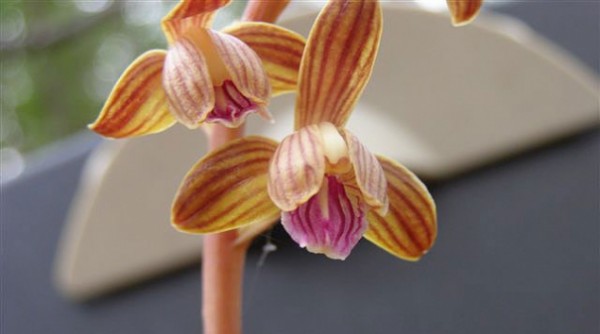
Rare Orchid Found in PHP
The month of May brought about a rare and wonderful sight at Hardberger Park—a terrestrial orchid, the crested coralroot (Hexalectris spicata).
Oddly enough, Texas is home to 54 orchids, all of which are terrestrial (Liggio and Liggio, Wild Orchids of Texas, 1999). This differs from tropical orchids which are mainly epiphytic (air plants) (Liggio and Liggio 1999). It may be surprising to some that, like grasses, palms, and lilies, orchids are actually monocots (Brown, Field Guide to the Wild Orchids of Texas, 2008).
 Perhaps the most prominent characteristics of all the orchids are the typical 3 sepal, 2 petal flower structure. A third petal is modified into a type of landing platform for insects (Brown 2008). Most of the Texas orchids occur in the moist conditions of east Texas (Liggio and Liggio 1999). However, some of the most unusual Texas orchids occur in the Edward’s Plateau region and right here in Bexar County. These are members of the Corallorhiza and Hexalectris genus. Unlike other orchids, these lack chlorophyll and thus do not carryout photosynthesis. These plants, traditionally termed saprophytic, derive their nutrients from decaying leaves and vegetation (Liggio and Liggio 1999).
Perhaps the most prominent characteristics of all the orchids are the typical 3 sepal, 2 petal flower structure. A third petal is modified into a type of landing platform for insects (Brown 2008). Most of the Texas orchids occur in the moist conditions of east Texas (Liggio and Liggio 1999). However, some of the most unusual Texas orchids occur in the Edward’s Plateau region and right here in Bexar County. These are members of the Corallorhiza and Hexalectris genus. Unlike other orchids, these lack chlorophyll and thus do not carryout photosynthesis. These plants, traditionally termed saprophytic, derive their nutrients from decaying leaves and vegetation (Liggio and Liggio 1999).
Hexalectris spicata found late this spring at Hardberger Park is more accurately termed by recent publications as myco-heterotrophic instead of saprophytic. The plant derives nutrients, starches, and sugars from mycorrhizal fungal associations with the roots (Poole et al, Rare Plants of Texas, 2007). But perhaps the most amazing and interesting fact of all, because orchid seeds lack an endosperm, seeds have to fall right where the mycorrhizal  fungus is in order to further develop (Liggio and Liggio 1999). So, conditions have to be perfect not only in order for the leafless plants to emerge from the ground but also for the seeds to develop. <em>Hexalectris spicata</em> or Crested Coral Root can be found in live oak woodlands in the Edward’s Plateau, growing out of decaying leaf litter (Liggio and Liggio 1999; Brown 2008). The color of the stems, which can reach up to 80 cm tall, can vary but are usually deep purple (Brown 2008). PHP Staff was excited to see this rare beauty at Hardberger Park, protected from the destructive hand of man.
fungus is in order to further develop (Liggio and Liggio 1999). So, conditions have to be perfect not only in order for the leafless plants to emerge from the ground but also for the seeds to develop. <em>Hexalectris spicata</em> or Crested Coral Root can be found in live oak woodlands in the Edward’s Plateau, growing out of decaying leaf litter (Liggio and Liggio 1999; Brown 2008). The color of the stems, which can reach up to 80 cm tall, can vary but are usually deep purple (Brown 2008). PHP Staff was excited to see this rare beauty at Hardberger Park, protected from the destructive hand of man.
